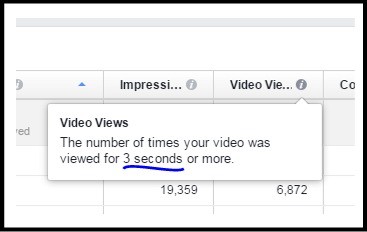Last updated on May 5, 2020
Here’s how Facebook is cheating advertisers with reporting of video views:

How is that cheating? Well, the advertiser implicitly assumes that ‘video views’ means people who have actually watched the video which is not the case here. Say, you have a 10-second video; this metric does not show people who have watched that video till the end, but only those who have watched the first three seconds — possibly just scrolling their newsfeeds and letting the video autoplay accidentally while quickly browsing forward. Essentially, that kind of exposure is worth closer to zero than the 1 cent Facebook usually reports.
Indeed, other view-based metrics such as CPV should be calculated based on somebody watching the video till the end, but in FB it’s 3 SECONDS after which they calculate it as a view. In effect, this will multiply the real CPV by order of several magnitudes, in some cases I’ve seen it’s 10x more than the figure reported by Facebook.
But aren’t they telling this honestly? Sure, they show the correct definition, but a large part of advertisers do not bother looking at it, or are unsuspecting misguiding definitions. After all, you should be able to trust that a big and reputable player like Facebook would not screw over advertisers. However, those of us who have played the game for many years know it’s not the first time (remember their definition of “click” a couple of years ago?).
What’s more, there’s no metric for the real CPV in the reports, so advertisers need to calculate it manually (at which point, based on my experience, it’s revealed that Facebook video views are are typically 5x more expensive than on Youtube).
How to avoid this shenanigans? Simply look at the metric ‘video views to 100%’. This is the real video views metric you should use – calculate your spend with that number, and you will get your true CPV. In other words:
ad cost / views to 100%
Keep your eyes open, my fellow advertisers!
UPDATE: Another good tactic, pointed out by my colleague Tommi Salenius, is to bid for 10-second views in your video campaigns. This is a relatively novel feature in Facebook, and although it doesn’t fix the problem, it’s a decent workaround. He also recommended to optimize “average % viewed” metric – you can do that e.g. by comparing different demographic segments. Finally, Facebook video ads can be seen to have a “social advantage” which refers to people’s ability to comment and like videos – sometimes this does take place 🙂 The advertiser can also include more text than in Youtube video ads which has a positive effect on ad prominence. It is then up to the advertiser to consider whether these advantages are worth the cost premium Facebook tends to have in comparison to Youtube.